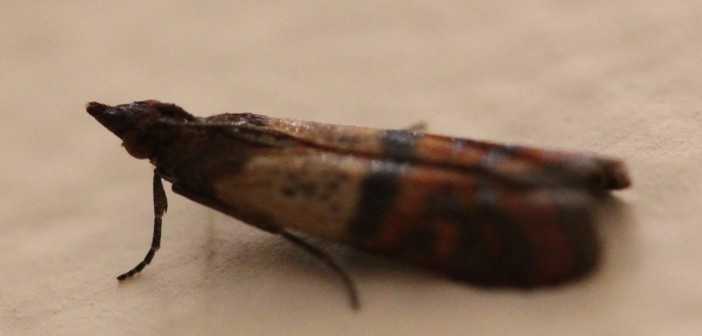Named Indian Meal Moths because of their habit of infesting corn meal, in earlier days called “Indian meal,” and also known as the flour or grain moth, meal moths are the most common of dry foods pests. One may find the larvae in boxes of cereal, bags of bread, boxes of spaghetti, in flour bags, on nuts and dehydrated fruit, or in dog or cat food. These moths have no shame- they even infest chocolate! And how did they get into your pantry? Likely you bought products at the grocery store that were covered with their tiny eggs and brought them home with you.
Then they hatched, grew into larvae, and started feasting on your bran flakes. They spin silky webs into which are caught their feces and their old shed skins- not what you want to eat for breakfast!
If you see their pale larvae crawling around on the ceilings or walls, or see the full-grown 3/8 inch long moths flying in your house or hiding in your closet, you need to check your pantry. The larvae leave their original food source to pupate, and the moths will fly far from where they began, so do not suppose that where you find them is where the problem started. The moths are gray with bronze on the back parts of their wings and are easily distinguished from other moths. This moth’s zig-zag flight pattern also helps to identify it. The larvae are a cream-ish color, often with dark brown on their heads.
To eradicate these pests, there are a number of strategies you might employ. First, you can put a moth trap with a sticky inside coating and some kind of bait into your foodstuffs. Non-toxic traps (pheromone traps) are available that will not make your food poisonous. Another option is to freeze for a week any food they might feed on since they cannot survive the cold- not even as eggs. A simple, but effective method is to toss all infested food or potentially infested food, search close for the larvae in the pantry and beyond, capture and kill all of them, and clean the formerly infested area thoroughly with soap and water. If some items are un-sealed or loosely sealed or have been in the pantry for quite a while, you should suspect them of infestation. Check everything. Check the small nooks and crannies for hiding larvae to prevent a re-infestation.
To prevent further meal moth problems, or at least minimize them, keep all food in sealed containers. Transfer cereals and pastas from the store boxes into air tight storage bottles. These moths are able to get in through the tiniest holes or to chew their way in through some plastic bags, so make sure all the food is well secured. Some prefer to use the traps rather than constantly transfer food to new storage bins. Refrigerator storage can do the trick too if you can spare the space. Meal moths are notoriously hard to get rid of permanently, and if you struggle with repeated infestations, you can consider avoiding the purchase of the food products on which the eggs seem to have arrived. Otherwise, you may wish to contact a professional exterminator.
According to Indianmealmoths.com, commonest and most destructive of all the pantry moths, the Indian Meal Moth is the cause of much food waste in the pantries of America and other nations. Lost food means lost finances. The larvae are particularly repugnant and remind one of maggots. The manner in which food is covered by them in silky feces-containing material is an unpleasant shock to the man or woman looking in the cupboard for something good to eat. Ordinary pesticides fail since one does not want to poison one’s own food. Therefore traps are used, or the food is simply thrown out and the mess cleaned up. Freezing or sealing potentially in danger food items is the best preventative cure.




